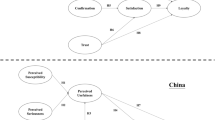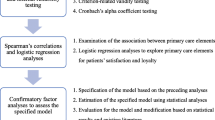Abstract
Drawing on a sample of 245 patients from a tertiary general hospital in China, we examine the effect of perceived service quality of traditional Chinese medicine (TCM) on patient loyalty. At the same time, both the mediating effect of patient attitude and the moderating effect of familiarity are tested. We find that perceived service quality of TCM has a positive effect on patient loyalty and this relationship is mediated by patient attitude. We also find that moderating effect of patient familiarity with TCM is not supported by the study. Finally, implications for management theory and practice are discussed.

Similar content being viewed by others
References
Alba JW, Hutchinson JW (1987) Dimensions of consumer expertise. J Consum Res 13(4):411–454
Batra R, Ray ML (1986) Affective responses mediating acceptance of advertising. J Consum Res 13(2):234–249
Bettina R, Abdolkarim S (2012) Sharing information. J Econ Behav Organ 81:689–698
Bloemer J, Ruyter KD, Wetzels M (1999) Linking perceived service quality and service loyalty: a multi-dimensional perspective. Eur J Mark 33(11/12):1082–1106
Bloemer JM, Kasper HDP (1995) The complex relationship between consumer satisfaction and brand loyalty. J Econ Psychol 16(2):311–329
Chang CS, Chen SY, Lan YT (2013) Service quality, trust, and patient satisfaction in interpersonal-based medical service encounters. BMC Health Serv Res 13(1):22–32
Chen FP, Chen TJ, Kung YY, Chen YC, Chou LF, Chen FJ, Hwang SJ (2007) Use frequency of traditional Chinese medicine in Taiwan. BMC Health Serv Res 7(1):26–36
China N (2017) National administration of traditional Chinese medicine of China (2013–2017) statistical extract of traditional Chinese medicine in china. http://www.satcm.gov.cn/2017tjzb/start.htm
Cronin JJ, Taylor SA (1992) Measuring service quality: a reexamination and extension. J Mark 56(3):55–68
Day GS (1976) A two-dimensional concept of brand loyalty. J Advert Res 9:29–35
Faircloth JB, Capella LM, Alford BL (2001) The effect of brand attitude and brand image on brand equity. J Mark Theory Pract 9(3):61–75
Fan X, Du JG (2006) The effect of five-dimensional service quality on the degreeof satisfaction to service and loyalty. Manag World 6:36–46
Fisher RJ (1993) Social desirability bias and the validity of indirect questioning. J Consum Res 20(2):303–315
Gresham LG, Shimp TA (1985) Attitude toward the advertisement and brand attitudes: a classical conditioning perspective. J Advert 14(1):10–17
Groth M (2005) Customers as good soldiers: examining citizenship behaviors in internet service deliveries. J Manag 31(1):7–27
Ha HY, Perks H (2010) Effects of consumer perceptions of brand experience on the web: brand familiarity, satisfaction and brand trust. J Consum Behav 4(6):438–452
Hayes A (2013) Introduction to mediation, moderation, and conditional process analysis: a regression-based approach. The Guilford Press, New York
He L (2012) Measurement of the higher education service quality: an exploratory study of servqual scale. J Xi’an Jiaotong Univ 32(116):121–125
Jacoby J, Kyner DB (1973) Brand loyalty vs. repeat purchasing behavior. J Mark Res 10(1):1–9
Johnson M, Zinkhan GM, Ayala GS (1998) The impact of outcome, competency and affect on service referral. J Serv Mark 12(5):397–415
Kim J, Chan-Olmsted SM (2005) Comparative effects of organization-public relationships and product-related attributes on brand attitude. J Mark Commun 11(3):145–170
Ljubič ić M (1996) Brand familiarity and confidence as determinants of purchase intention: An empirical test in a multiple brand context. J Bus Res 37(2):115–120
Low GS, Lamb CW Jr (2000) The measurement and dimensionality of brand associations. J Product Brand Manag 9(6):350–370
Nestler G (2002) Traditional Chinese medicine. Med Clin N Am 86(1):63–73
Parasuraman A, Grewal D (2000) The impact of technology on the quality-value-loyalty chain: a research agenda. J Acad Market Sci 28(1):168–174
Parasuraman A, Zeithaml VA, Berry LL (1988) Servqual: a multiple-item scale for measuring consumer perceptions of service quality. J Retail 64(1):12–40
Parasuraman A, Zethhaml VA, Berry LL (1994) Alternative scales for measuring service quality: a comparative assessment based on psychometric and diagnostic criteria. J Retail 70(3):193–194
Parasuraman A, Berry LL, Zeithaml VA (2010) Perceived service quality as a customer-based performance measure: an empirical examination of organizational barriers using an extended service quality model. Hum Resource Manag 30(3):335–364
Park CW, Lessig VP (1981) Familiarity and its impact on consumer decision biases and heuristics. J Consum Res 8(2):223–231
Park J, Stoel L (2005) Effect of brand familiarity, experience and information on online apparel purchase. Int J Retail Distrib 33(2):148–160
Podsakoff PM, Mackenzie SB, Jeong-Yeon L, Podsakoff NP (2003) Common method biases in behavioral research: a critical review of the literature and recommended remedies. J Appl Psychol 88(5):879–903
Söderlund M (2010) Customer familiarity and its effects on satisfaction and behavioral intentions. Psychol Market 19(10):861–879
Tam JLM (2008) Brand familiarity: its effects on satisfaction evaluations. J Serv Mark 22(22):3–12
Teas RK (1994) Expectations as a comparison standard in measuring service quality: an assessment of a reassessment. J Mark 58(1):132–139
Thompson CJ, Rindfleisch A, Arsel Z (2006) Emotional branding and the strategic value of the doppelgänger brand image. J Mark 70(1):50–64
Wang D, Feng L, Yin Y, Wang J, Wang Y (2015) Prioritized surgery scheduling in face of surgeon tiredness and fixed off-duty period. J Comb Optim 30(4):967–981
Wu Z (2006) Brand of traditional Chinese medicine: how to save savers themselves. China Health Ind 1:40–43
Xi C, Liu Z, Liang H, Lai KK (2017) Matching patients and healthcare service providers: a novel two-stage method based on knowledge rules and OWA-NSGA-II algorithm. J Comb Optim 37(1):221–247
Zeithaml VA, Berry LL, Parasuraman A (1996) The behavioral consequences of service quality. J Mark 60(2):31–46
Acknowledgements
The authors thank anonymous referees and editors whose comments helped to improve our study. This study was supported by research grants from the National Natural Science Foundation of China (Grant No. 71572130), the Fundamental Research Funds for the Central Universities (Grant No. 22120180074).
Author information
Authors and Affiliations
Corresponding author
Additional information
Publisher's Note
Springer Nature remains neutral with regard to jurisdictional claims in published maps and institutional affiliations.
Rights and permissions
About this article
Cite this article
Li, H., Wang, L., Xia, X. et al. Perceived service quality’s effect on patient loyalty through patient attitude within the context of traditional Chinese medicine. J Comb Optim 42, 1030–1041 (2021). https://doi.org/10.1007/s10878-019-00520-z
Published:
Issue Date:
DOI: https://doi.org/10.1007/s10878-019-00520-z




